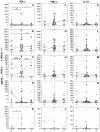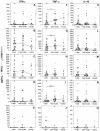Hemozoin differentially regulates proinflammatory cytokine production in human immunodeficiency virus-seropositive and -seronegative women with placental malaria
- PMID: 15557625
- PMCID: PMC529128
- DOI: 10.1128/IAI.72.12.7022-7029.2004
Hemozoin differentially regulates proinflammatory cytokine production in human immunodeficiency virus-seropositive and -seronegative women with placental malaria
Abstract
Pregnant women are at an increased risk for malarial infection. Plasmodium falciparum accumulates in the placenta and is associated with dysregulated immune function and poor birth outcomes. Malarial pigment (hemozoin) also accumulates in the placenta and may modulate local immune function. In this study, the impact of hemozoin on cytokine production by intervillous blood mononuclear cells from malaria-infected placentas was investigated. There was a dose-dependent, suppressive effect of hemozoin on production of gamma interferon (IFN-gamma), with less of an effect on tumor necrosis factor alpha (TNF-alpha) and interleukin-10, in human immunodeficiency virus-seronegative (HIV(-)) women. In contrast, IFN-gamma and TNF-alpha production tended to increase in HIV-seropositive women with increasing hemozoin levels. Production patterns of cytokines, especially IFN-gamma in HIV(-) women, followed different trends as a function of parasite density and hemozoin level. The findings suggest that the influences of hemozoin accumulation and high-density parasitemia on placental cytokine production are not equivalent and may involve different mechanisms, all of which may operate differently in the context of HIV infection. Cytokine production dysregulated by accumulation of hemozoin or high-density parasitemia may induce pathology and impair protective immunity in HIV-infected and -uninfected women.
Figures


Similar articles
-
IL-12 producing monocytes and IFN-gamma and TNF-alpha producing T-lymphocytes are increased in placentas infected by Plasmodium falciparum.J Reprod Immunol. 2007 Jun;74(1-2):152-62. doi: 10.1016/j.jri.2006.10.001. Epub 2006 Dec 27. J Reprod Immunol. 2007. PMID: 17194481
-
Immunity to placental malaria. I. Elevated production of interferon-gamma by placental blood mononuclear cells is associated with protection in an area with high transmission of malaria.J Infect Dis. 1999 May;179(5):1218-25. doi: 10.1086/314737. J Infect Dis. 1999. PMID: 10191226
-
Malaria and pregnancy: placental cytokine expression and its relationship to intrauterine growth retardation.J Infect Dis. 1999 Dec;180(6):1987-93. doi: 10.1086/315135. J Infect Dis. 1999. PMID: 10558956
-
Malaria blood-stage infection and its control by the immune system.Folia Biol (Praha). 2000;46(6):210-8. Folia Biol (Praha). 2000. PMID: 11140853 Review.
-
Malaria in pregnancy: pathogenesis and immunity.Lancet Infect Dis. 2007 Feb;7(2):105-17. doi: 10.1016/S1473-3099(07)70022-1. Lancet Infect Dis. 2007. PMID: 17251081 Review.
Cited by
-
Oxidative stress in malaria.Int J Mol Sci. 2012 Dec 3;13(12):16346-72. doi: 10.3390/ijms131216346. Int J Mol Sci. 2012. PMID: 23208374 Free PMC article. Review.
-
Natural hemozoin stimulates syncytiotrophoblast to secrete chemokines and recruit peripheral blood mononuclear cells.Placenta. 2011 Aug;32(8):579-85. doi: 10.1016/j.placenta.2011.05.003. Epub 2011 May 31. Placenta. 2011. PMID: 21632106 Free PMC article.
-
Insights Into Circulating Cytokine Dynamics During Pregnancy in HIV-Infected Beninese Exposed to Plasmodium falciparum Malaria.Am J Trop Med Hyg. 2015 Aug;93(2):287-92. doi: 10.4269/ajtmh.14-0653. Epub 2015 Jun 22. Am J Trop Med Hyg. 2015. PMID: 26101276 Free PMC article. Clinical Trial.
-
Maternal malaria induces a procoagulant and antifibrinolytic state that is embryotoxic but responsive to anticoagulant therapy.PLoS One. 2012;7(2):e31090. doi: 10.1371/journal.pone.0031090. Epub 2012 Feb 7. PLoS One. 2012. PMID: 22347435 Free PMC article.
-
Cytokine-associated neutrophil extracellular traps and antinuclear antibodies in Plasmodium falciparum infected children under six years of age.Malar J. 2008 Feb 29;7:41. doi: 10.1186/1475-2875-7-41. Malar J. 2008. PMID: 18312656 Free PMC article.
References
-
- Arese, P., and E. Schwarzer. 1997. Malarial pigment (haemozoin): a very active ‘inert' substance. Ann. Trop. Med. Parasitol. 91:501-516. - PubMed
-
- Artavanis-Tsakonas, K., K. Eleme, K. L. McQueen, N. W. Cheng, P. Parham, D. M. Davis, and E. M. Riley. 2003. Activation of a subset of human NK cells upon contact with Plasmodium falciparum-infected erythrocytes. J. Immunol. 171:5396-5405. - PubMed
-
- Bouyou-Akotet, M. K., S. Issifou, J. F. Meye, M. Kombila, E. Ngou-Milama, A. J. Luty, P. G. Kremsner, and E. Mavoungou. 2004. Depressed natural killer cell cytotoxicity against Plasmodium falciparum-infected erythrocytes during first pregnancies. Clin. Infect. Dis. 38:342-347. - PubMed
-
- Bulmer, J. N., F. N. Rasheed, N. Francis, L. Morrison, and B. M. Greenwood. 1993. Placental malaria. I. Pathological classification. Histopathology 22:211-218. - PubMed
-
- Chaisavaneeyakorn, S., J. M. Moore, L. Mirel, C. Othoro, J. Otieno, S. C. Chaiyaroj, Y. P. Shi, B. L. Nahlen, A. A. Lal, and V. Udhayakumar. 2003. Levels of macrophage inflammatory protein 1α (MIP-1α) and MIP-1β in intervillous blood plasma samples from women with placental malaria and human immunodeficiency virus infection. Clin. Diagn. Lab. Immunol. 10:631-636. - PMC - PubMed
Publication types
MeSH terms
Substances
Grants and funding
LinkOut - more resources
Full Text Sources
Medical

